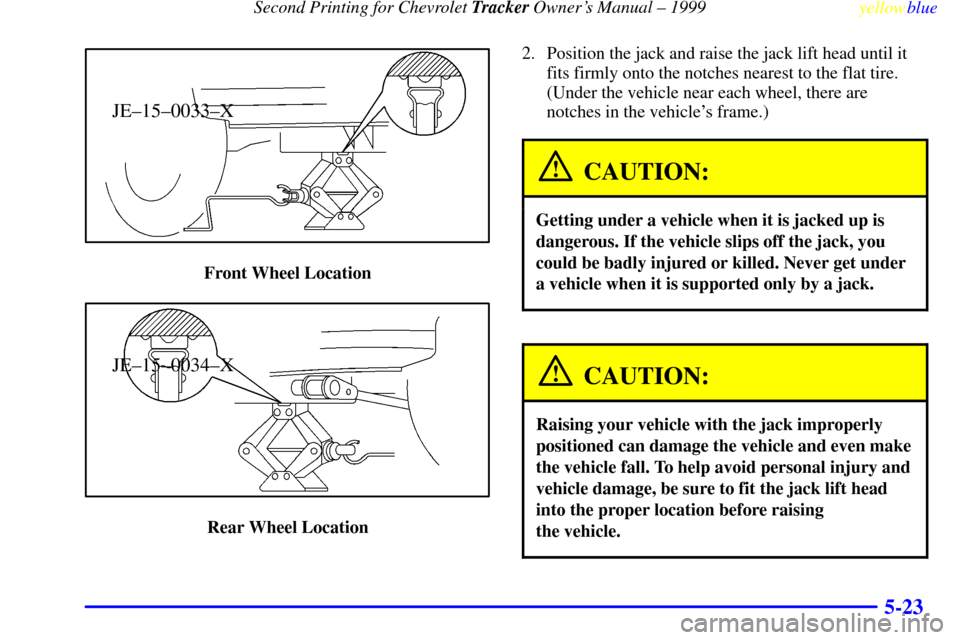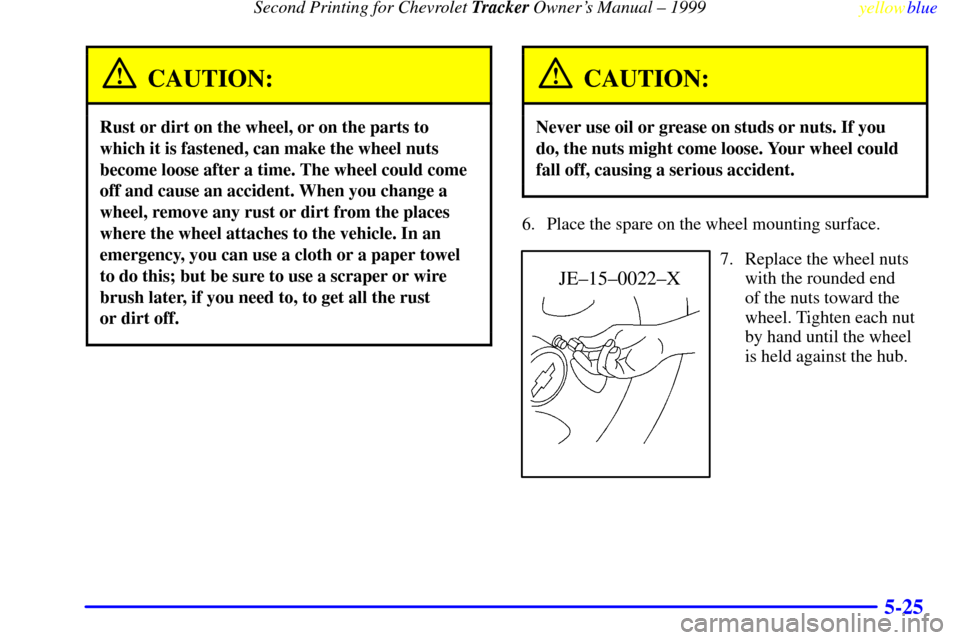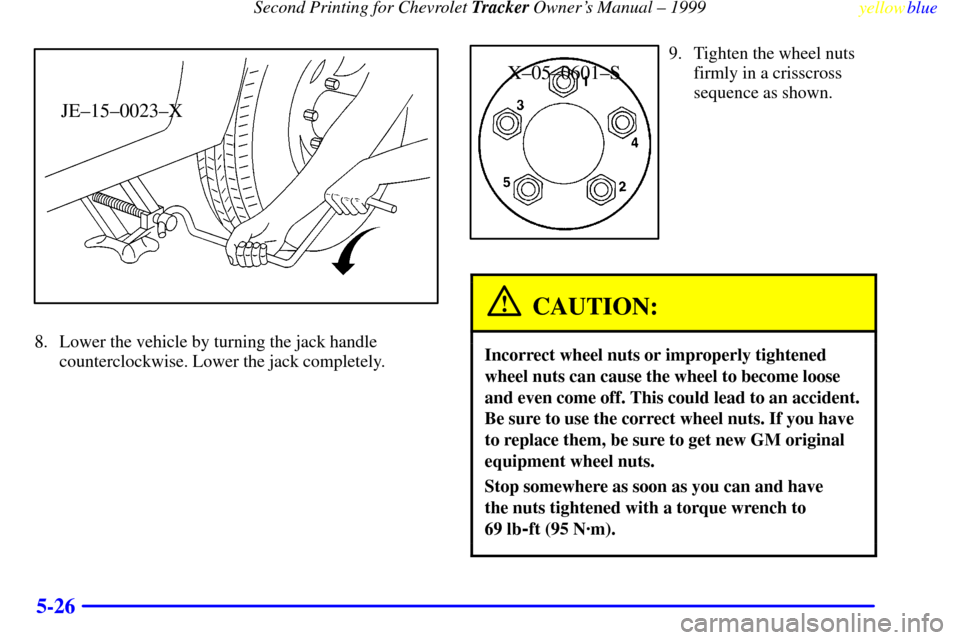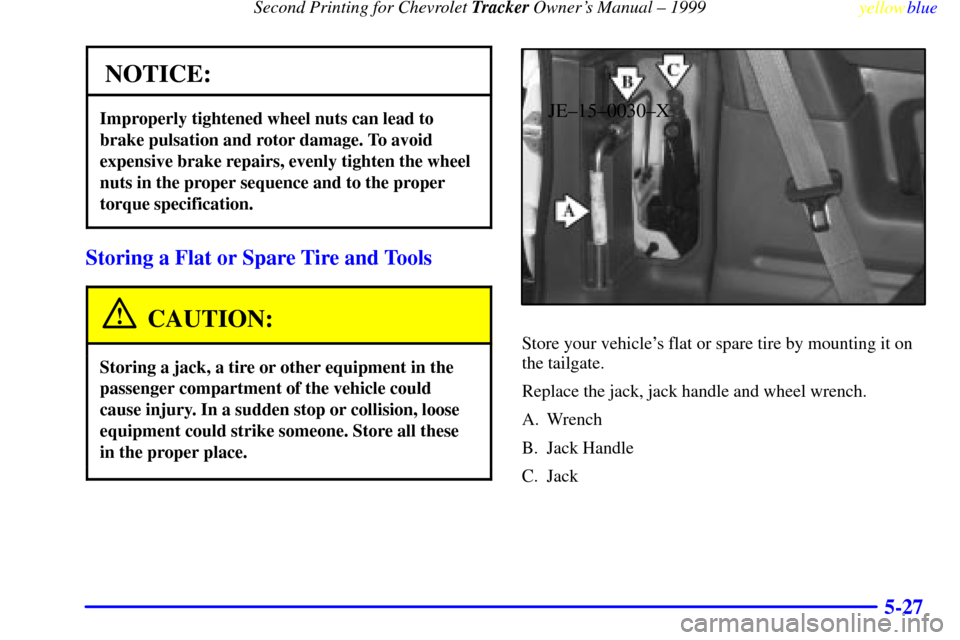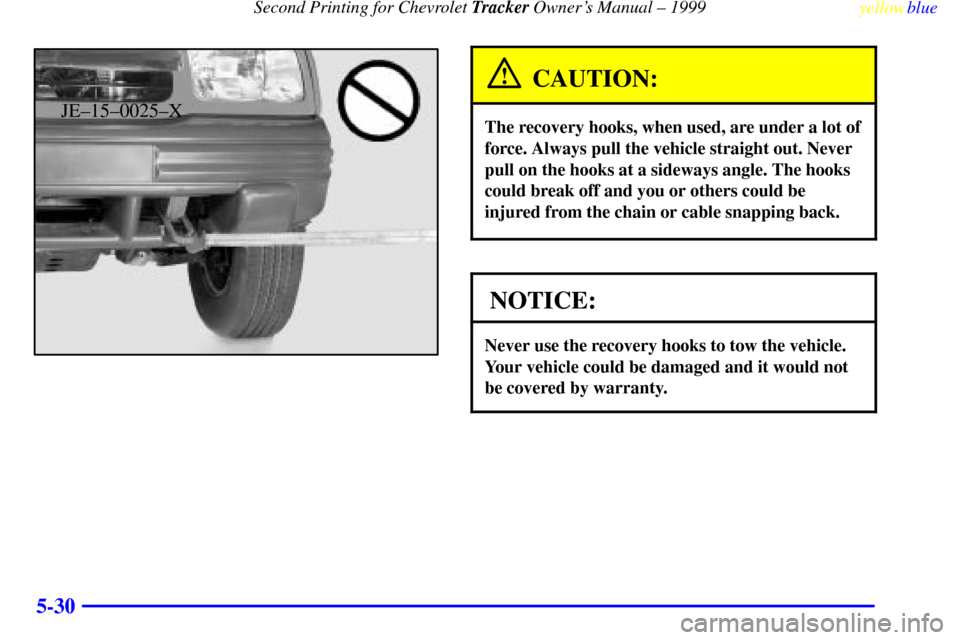CHEVROLET TRACKER 1999 2.G Owners Manual
TRACKER 1999 2.G
CHEVROLET
CHEVROLET
https://www.carmanualsonline.info/img/24/8348/w960_8348-0.png
CHEVROLET TRACKER 1999 2.G Owners Manual
Trending: change language, manual radio set, oil temperature, octane, lock, child lock, turn signal bulb
Page 221 of 376
Second Printing for Chevrolet Tracker Owner's Manual ± 1999
yellowblue
5-23
JE±15±0033±X
Front Wheel Location
JE±15±0034±X
Rear Wheel Location2. Position the jack and raise the jack lift head until it
fits firmly onto the notches nearest to the flat tire.
(Under the vehicle near each wheel, there are
notches in the vehicle's frame.)
CAUTION:
Getting under a vehicle when it is jacked up is
dangerous. If the vehicle slips off the jack, you
could be badly injured or killed. Never get under
a vehicle when it is supported only by a jack.
CAUTION:
Raising your vehicle with the jack improperly
positioned can damage the vehicle and even make
the vehicle fall. To help avoid personal injury and
vehicle damage, be sure to fit the jack lift head
into the proper location before raising
the vehicle.
Page 222 of 376
Second Printing for Chevrolet Tracker Owner's Manual ± 1999
yellowblue
5-24
JE±15±0021±X
3. Raise the vehicle by turning the jack handle
clockwise. Raise the vehicle far enough off the
ground so there is enough room for the spare
tire to fit.
JE±15±0022±X
4. Remove all the wheel
nuts and take off the
flat tire.
X±05±0617±T
5. Remove any rust or dirt
from the wheel bolts,
mounting surfaces and
spare wheel.
Page 223 of 376
Second Printing for Chevrolet Tracker Owner's Manual ± 1999
yellowblue
5-25
CAUTION:
Rust or dirt on the wheel, or on the parts to
which it is fastened, can make the wheel nuts
become loose after a time. The wheel could come
off and cause an accident. When you change a
wheel, remove any rust or dirt from the places
where the wheel attaches to the vehicle. In an
emergency, you can use a cloth or a paper towel
to do this; but be sure to use a scraper or wire
brush later, if you need to, to get all the rust
or dirt off.
CAUTION:
Never use oil or grease on studs or nuts. If you
do, the nuts might come loose. Your wheel could
fall off, causing a serious accident.
6. Place the spare on the wheel mounting surface.
JE±15±0022±X
7. Replace the wheel nuts
with the rounded end
of the nuts toward the
wheel. Tighten each nut
by hand until the wheel
is held against the hub.
Page 224 of 376
Second Printing for Chevrolet Tracker Owner's Manual ± 1999
yellowblue
5-26
JE±15±0023±X
8. Lower the vehicle by turning the jack handle
counterclockwise. Lower the jack completely.
X±05±0601±S
9. Tighten the wheel nuts
firmly in a crisscross
sequence as shown.
CAUTION:
Incorrect wheel nuts or improperly tightened
wheel nuts can cause the wheel to become loose
and even come off. This could lead to an accident.
Be sure to use the correct wheel nuts. If you have
to replace them, be sure to get new GM original
equipment wheel nuts.
Stop somewhere as soon as you can and have
the nuts tightened with a torque wrench to
69 lb
-ft (95 N´m).
Page 225 of 376
Second Printing for Chevrolet Tracker Owner's Manual ± 1999
yellowblue
5-27
NOTICE:
Improperly tightened wheel nuts can lead to
brake pulsation and rotor damage. To avoid
expensive brake repairs, evenly tighten the wheel
nuts in the proper sequence and to the proper
torque specification.
Storing a Flat or Spare Tire and Tools
CAUTION:
Storing a jack, a tire or other equipment in the
passenger compartment of the vehicle could
cause injury. In a sudden stop or collision, loose
equipment could strike someone. Store all these
in the proper place.
JE±15±0030±X
Store your vehicle's flat or spare tire by mounting it on
the tailgate.
Replace the jack, jack handle and wheel wrench.
A. Wrench
B. Jack Handle
C. Jack
Page 226 of 376

Second Printing for Chevrolet Tracker Owner's Manual ± 1999
yellowblue
5-28
If You're Stuck: In Sand, Mud,
Ice or Snow
In order to free your vehicle when it is stuck, you will
need to spin the wheels, but you don't want to spin your
wheels too fast. The method known as ªrockingº can
help you get out when you're stuck, but you must
use caution.
CAUTION:
If you let your tires spin at high speed, they can
explode, and you or others could be injured. And,
the transmission or other parts of the vehicle can
overheat. That could cause an engine
compartment fire or other damage. When you're
stuck, spin the wheels as little as possible. Don't
spin the wheels above 35 mph (55 km/h) as shown
on the speedometer.
NOTICE:
Spinning your wheels can destroy parts of your
vehicle as well as the tires. If you spin the wheels
too fast while shifting your transmission back
and forth, you can destroy your transmission.
For information about using tire chains on your vehicle,
see ªTire Chainsº in the Index.
Page 227 of 376
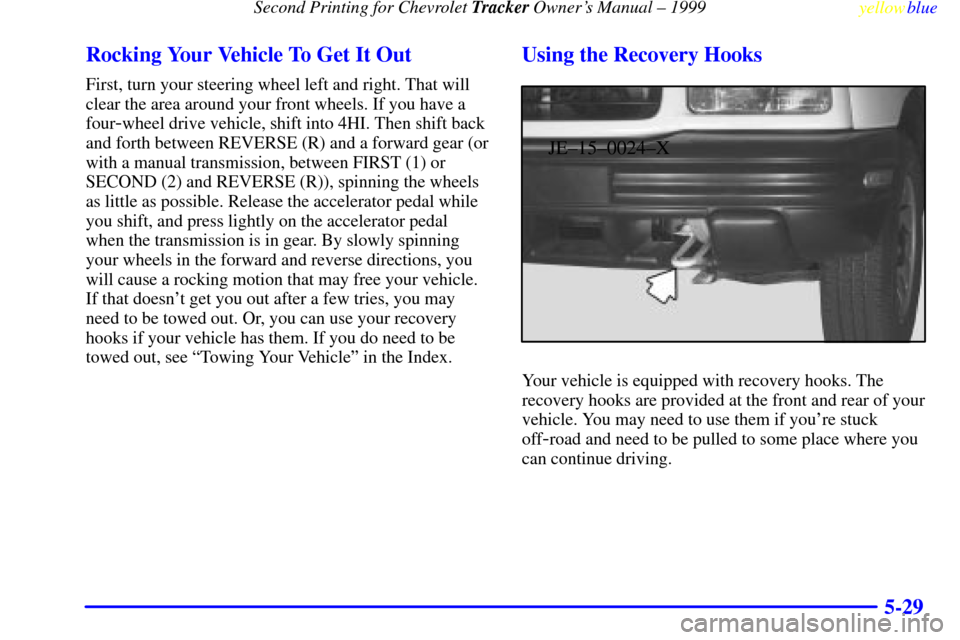
Second Printing for Chevrolet Tracker Owner's Manual ± 1999
yellowblue
5-29 Rocking Your Vehicle To Get It Out
First, turn your steering wheel left and right. That will
clear the area around your front wheels. If you have a
four
-wheel drive vehicle, shift into 4HI. Then shift back
and forth between REVERSE (R) and a forward gear (or
with a manual transmission, between FIRST (1) or
SECOND (2) and REVERSE (R)), spinning the wheels
as little as possible. Release the accelerator pedal while
you shift, and press lightly on the accelerator pedal
when the transmission is in gear. By slowly spinning
your wheels in the forward and reverse directions, you
will cause a rocking motion that may free your vehicle.
If that doesn't get you out after a few tries, you may
need to be towed out. Or, you can use your recovery
hooks if your vehicle has them. If you do need to be
towed out, see ªTowing Your Vehicleº in the Index.
Using the Recovery Hooks
JE±15±0024±X
Your vehicle is equipped with recovery hooks. The
recovery hooks are provided at the front and rear of your
vehicle. You may need to use them if you're stuck
off
-road and need to be pulled to some place where you
can continue driving.
Page 228 of 376
Second Printing for Chevrolet Tracker Owner's Manual ± 1999
yellowblue
5-30
JE±15±0025±X
CAUTION:
The recovery hooks, when used, are under a lot of
force. Always pull the vehicle straight out. Never
pull on the hooks at a sideways angle. The hooks
could break off and you or others could be
injured from the chain or cable snapping back.
NOTICE:
Never use the recovery hooks to tow the vehicle.
Your vehicle could be damaged and it would not
be covered by warranty.
Page 229 of 376
Second Printing for Chevrolet Tracker Owner's Manual ± 1999
yellowblue
5-31
-NOTES
Page 230 of 376
Second Printing for Chevrolet Tracker Owner's Manual ± 1999
yellowblue
5-32
-NOTES
Trending: fog light, inflation pressure, heater, reset, wiper fluid, sport mode, oil capacities
